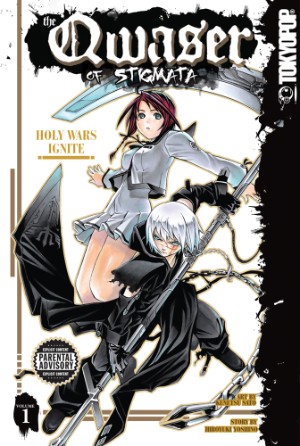Though I frequently grouse about fanservice , I have a grudging respect for those artists who make costume failures, panty shots, and general shirtlessness play essential roles in advancing their plots. Consider Pretty Face, the story of a teenage jock who undergoes reconstructive surgery after a bus accident, only to end up looking like the girl he has a crush on (at least from the waist up). You don’t need to be a pervert to imagine how Yasuhiro Kano exploits the set-up for maximum T&A potential — even the hero gets groped and ogled, though Rando isn’t above leering at and lusting after girls himself. I loathe Pretty Face, yet I have to admit that Kano obviates the need for gusts of wind and breast-level collisions by making gender confusion such a fundamental part of his story; the fanservice may be gross and stupid, but it isn’t gratuitous.
Then there’s The Qwaser of Stigmata.
Qwaser raises the panty-shot-as-plot-element stakes, then kicks Pretty Face down the stairs, taunts it, and takes its lunch money with a gimmick so offensive I’m almost embarrassed to type the words: the characters rely on breast milk for their superpowers. Those characters have chosen St. Mihailov Academy as ground zero for an epic showdown involving religious icons, nubile maidens, and weapons derived from the periodic table of the elements. (No doubt Dmitri Mendeleev is tossing in his grave right now.) From the standpoint of an artist writing for a shonen magazine like Monthly Champion Red, the parochial school setting provides the perfect vehicle for celebrating fetishes under the guise of world-building. No stone goes unturned, from busty nuns and busty schoolgirls to moe-bait characters in spectacles and knee socks; there’s even a bit of fan service for the ladies that takes the form of a smoldering priest in an eyepatch and a sullen, silver-haired Russian named Alexander “Sasha” Nikolaevich Hell. (Or “Her,” in the Tokyopop translation.)
As with most manga featuring combatants of the cloth, the religious iconography seems more a pretext for cool outfits than an integral part of the story. The characters occasionally pause to contemplate the Theotokos of Tsarytsin, a religious icon depicting the Virgin Mary nursing the baby Jesus, but why they want the icon remains mysterious; only by consulting the Wikipedia entry on Qwaser did I learn that this particular image is “fabled to alter the homeostasis of the world.” For a manga exploring a religion that’s sure to be a mystery to most of its readers, in- and outside Japan, it’s curious that no one ever discusses what Russian Orthodox Christians believe, how they practice their faith, or what caused doctrinal crises within the Russian Church — a pity, because as this Slavophile will tell you, there is a boffo manga to be written about the Old Believers’ showdown with Peter the Great. (Don’t believe me? Rent a DVD of the Mariinski Theater’s production of Khovanshchina, an opera so badass that several characters immolate themselves rather than submit to Peter’s will.) The few other references to religion are more window-dressing than anything else; Qwasers, those holy warriors of the periodic table, fight alongside “Maria Magdalens,” described by Wikipedia’s anonymous authors as “the alter-ego combat partner of a Qwaser whose primary function is to provide soma [breast milk] not unlike how one may refuel a car or even a warplane while in flight.” (After reading that sentence, I’m not sure which is more egregious: the Wikipedia authors’ attempt to write about Qwaser in a pseudo-scientific voice, or the manga-ka’s decision to call these women “Maria Magdalens.”)
If the fanservice and faux-religious elements weren’t quite enough to land Qwaser a spot in The Manga Hall of Shame, the dreadful artwork and ADD plotting put it over the top. The fight scenes are utterly incomprehensible, a blur of speedlines, explosions, and whirling dervishes punctuated by the occasional pin-up drawing of a character brandishing a weapon or enduring some unpleasant, sexually tinged violence. The plotting isn’t much better, as the story skips between cliche scenes of classroom bullying and tortured, confusing conversations between the series’ two principal female characters. The dialogue takes the cake for sheer awfulness, however; it’s the kind of series in which villains state the atomic weight of the elements they’re manipulating, exclaim nonsense like “My heart that burns will slice through you!”, and utter things so vile that that the publisher substitutes the word “bleep” for references to female genitalia and sexual congress.
The bottom line: The Qwaser of Stigmata is a shonen manga that aspires to the subversiveness of porn, but doesn’t have the imagination or the weirdness to rise to the level of genuine kink.
THE QWASER OF STIGMATA, VOL. 1: HOLY WARS IGNITE • ART BY KENETSU SATO, STORY BY HIROYUKI YOSHINO • TOKYOPOP • 200 pp. • RATING: MATURE (18+)




Serdar says:
Why am I not surprised that this is a TokyoPop title?
Katherine Dacey says:
Makes me wonder why no one thought to emblazon the cover with the phrase, “From the people who brought you Tantric Stripfighter Trina and Grenadier!”
Erica says:
Readers who follow the kinds of details such as what magazine a manga runs in in Japan (which would be me and Sean Gaffney,) automatically shudder when the words “Champion Red” are uttered. There is no other “mainstream” manga magazine in Japan filled with as much dislike and disdain for women as Champion Red. (For comparison, the horrifically obnoxious manga versions of “My HiME” and “My Zhime” also ran in that magazine, as did the abusive nightmare of a manga for the delightful anime series “El Cazador de la Bruja.”)
When I wrote my review of the El Cazador manga, a Japanese friend commented that as soon as he saw the words “Champion Red” he knew exactly what I meant without ever having seen the manga itself.
Low does not adequately describe CR comics. “If you enjoyed this, (especially if you *really* enjoyed it, if you get my drift,) I’d like to introduce you to my friends Mr. Knife and Mr. Hot Tar” is pretty much my feeling about that whole magazine.
And for the record – the statement above is my *personal* opinion and does not reflect on this blog or anything Kate says here. Feel free to be angry at me for it, but please leave her out of it. Thanks in advance. ^_^
Michelle Smith says:
Although there are many other things I probably should be lamenting instead, my main thought is, “But why is that girl even lactating?!” I worry that horny teen boys will now assume that any busty girl is carrying around a few handy gallons at any given moment.
Katherine Dacey says:
@Erica: If Qwaser is indicative of the kind of series that run in Champion Red, I shudder to think what a typical issue looks like.
@Michelle: Oh, that thought crossed my mind several times, too! Guess we just have to hope that recent budgetary cutbacks in public education haven’t put sex ed on the chopping block, too.
Jim Yung says:
I remember when I used to get a few Tokyopop titles but I never seem to find titles of interest anymore.
Jade says:
‘Hello, do you love breasts?! I love them very much!’
As much as the fan service in this book grossly objectified women, I at least didn’t think it actively despised women like say…Bakuman. And to be fair, there’s a lot of breast-milk vampirism floating around folklore arounf the globe, but, yeah, I’m sure representing that was totally the intention here. :3
The scene with the priest giving orders to the nun really had some interesting subtext’s too. He makes a point to communicate that he is giving her these orders from patriarchal establishment X, Athos, but then we see that he really relishes ordering a woman to objectify herself like this, his innuendo driving home the entitlement intrinsic in their sect. I think whoever wrote that warplane line in the wiki entry completely missed the author’s point, Yoshino establishes the difference between the nurturing aspects of breast-feeding and the abuse of a woman’s breasts for fuel. It could be argued that it’s a bit like Utena in that way, but the levels of fan service obliterate any chance of making anything resembling a…you know, sorry, I feel dirty now, I’m done playng Devil’s Advocate.
I actually thought the element stuff in the battles was cool. I rolled my eyes at magnesium, but then I was impressed that they actually tapped aspects of the elements other than, ‘This sword is made out of magnesium! It’s gonna cut you!’ It’s too bad that this was utilised in such a terrible book, what a waste of an idea.
Katherine Dacey says:
@Jim Yung: I’m definitely buying fewer Tokyopop titles, too, in part because Tokyopop seems to be skewing a little… I’m not sure what word I’m looking for, but I find a lot of their books too frenetic for my taste. I did like Neko Ramen, however; I thought Tokyopop did a great job of adapting the text for English-speaking readers.
@Jade: You get an “A” for a patient, thorough reading of the text! Minus the milk fetish, Qwaser actually had a few interesting ideas behind it (e.g. Russian Orthodox iconography, manipulation of the elements), but nothing is presented with enough care or subtlety to make them really compelling. I admit that I didn’t read the scene you mention as carefully as you did; it just reminded me of a million “Catholic” manga in which the Vatican is depicted as some kind of secret police force that gives orders and bumps off unruly members. In light of what you said, I’ll have to go back and re-read it.
@Sean: Didn’t Cat Paradise also run in Champion Red? I actually like that series.
Sean G says:
To be fair to Champion Red, they have one series I love, the over the top horror comedy Franken Fran.
Everything else is scum-like.
Jade says:
Kate, yes, even if the interesting aspects were pulled off well, the potential is wasted on the many reasons to pass the book up. The boobs look nice, but everything else is fairly slap-dash. All in all, I think even someone inordinately fascinated by breasts can find better titles elsewhere.
You make a good point about that church scene just being the fascist church stand-by. You’re probably right, but I’m not seeing ‘women as fuel-tanks’ being portrayed as at all a good thing in the story. There are just a lot of odd conflicts between the fan-service and what’s actually being said in the book. The strangest example is how strongly the heroine is being portrayed as a protector character when it seems obvious that she’ll just become boob-fodder at some point.
Like I said before, the book may be offensive, but I don’t see it actually hating women and I think the creators did actually think they were creating something respectful of women much like Empowered. Misguided? Insensitive? Sure, but I’d like to try to nail down exactly what’s being said in the book rather than write off every last bit of it.